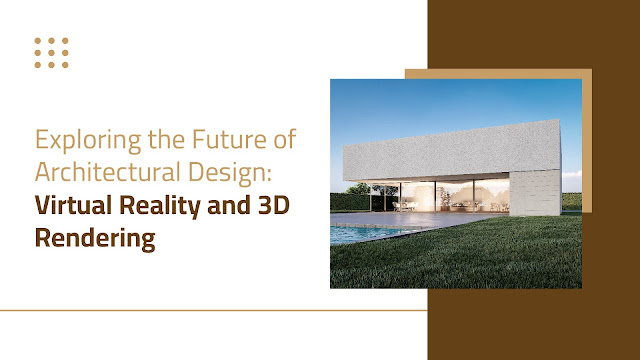Exploring the Future of Architectural Design: Virtual Reality and 3D Rendering
The architectural design landscape is
undergoing a significant transformation driven by rapid advancements in
technology. From the days of hand-drawn blueprints to the sophisticated
computer-aided design (CAD) tools of today, the field has continually evolved.
Now, virtual reality (VR) and 3D rendering are set to revolutionize
architectural design further. These technologies offer unprecedented
capabilities for visualization, accuracy, and client engagement, heralding a
new era in architecture.
The Current State of Architectural
Design Technology
Architectural design has always been at the
forefront of adopting modern technologies. Currently, tools like CAD and
Building Information Modeling (BIM) are standard in the industry. These tools
have streamlined the design process, improved accuracy, and facilitated better
project management. However, the integration of VR and advanced 3D rendering is
pushing these boundaries even further.
Leading firms are increasingly adopting
these technologies to stay competitive. For instance, VR allows architects to
create immersive environments where clients can walk through designs before
they are built. This not only enhances the client’s understanding of the
project but also helps in identifying potential issues early in the design
process. According to industry leaders, the combination of VR and 3D rendering
is becoming a critical differentiator in the market.
Harnessing Virtual Reality in
Architectural Design
Virtual reality has transformed how
architects visualize and present their designs. With VR, architects can create
fully immersive environments that clients can explore. This immersive
experience goes beyond traditional 2D or even 3D renderings, providing a
realistic sense of space and scale.
One of the most significant advantages of
VR is the ability to make real-time changes during presentations. Clients can
provide immediate feedback, and architects can adjust designs on the fly. This
interactive process not only improves client satisfaction but also enhances
collaboration, leading to more refined and accurate designs.
Several successful projects have
demonstrated the power of VR in architectural design. For example, a leading
firm used VR to design a new office building, allowing stakeholders to explore
different layout options and finishes before construction began. This resulted
in a final design that closely matched the client’s vision and reduced costly
changes during construction.
Advancements in 3D Rendering
3D rendering technology has seen remarkable
advancements, particularly in producing photorealistic images. Modern rendering
software can create highly detailed and realistic visualizations that
accurately depict materials, lighting, and textures. This level of detail helps
architects and clients make informed decisions about design elements.
Another significant advancement is the
speed and efficiency of 3D rendering. Tasks that once required days or even
weeks can now be completed within hours. This accelerated process allows
architects to iterate more quickly and explore multiple design options within
tight project timelines.
Additionally, the integration of 3D
rendering with other technologies, such as artificial intelligence (AI) and
machine learning, is opening new possibilities. AI can assist in generating
design alternatives based on specific criteria, while machine learning
algorithms can optimize rendering processes, further enhancing efficiency.
The Synergy Between VR and 3D Rendering
The combination of VR and 3D rendering
offers unparalleled capabilities for architectural visualization. Together,
they provide a comprehensive toolset that enhances every aspect of the design
process. For instance, detailed 3D renderings can be integrated into VR
environments, offering clients a highly realistic and immersive experience.
This synergy also improves design accuracy.
By visualizing detailed 3D models in a VR environment, architects can identify
and address potential issues early in the design phase. This reduces errors and
minimizes the need for costly changes during construction.
From a client perspective, the combination
of VR and 3D rendering enhances presentations. Clients can not only see
photorealistic images of their projects but also experience them in a virtual
environment. This dual approach improves understanding, satisfaction, and
decision-making.
Future Trends and Innovations
The future of architectural design is
poised for further innovation, with several trends on the horizon. Augmented
reality (AR) is one such trend that could complement VR and 3D rendering. AR
overlays digital information onto the physical world, providing architects with
new ways to visualize and interact with designs.
AI and machine learning will continue to
play a significant role in advancing these technologies. AI can assist in
optimizing designs for various parameters, such as energy efficiency and cost,
while machine learning can enhance rendering algorithms, making them faster and
more accurate.
Additionally, VR and 3D rendering can
contribute to sustainable design practices and the development of smart cities.
By providing detailed and accurate visualizations, these technologies can help
architects design buildings that are more efficient and environmentally
friendly.
Challenges and Considerations
Despite their many benefits, VR and 3D
rendering technologies face some challenges. Technical limitations, such as
hardware requirements and software compatibility, can be barriers to adoption.
Additionally, the cost of implementing these technologies can be prohibitive
for smaller firms.
Another consideration is the need for
ongoing training and skill development. Architects must continually update
their skills to keep pace with technological advancements.
As we look to the future, VR and 3Drendering will play a crucial role in shaping architectural design. These
technologies offer powerful tools for visualization, accuracy, and client
engagement, paving the way for more innovative and efficient design practices.
Architects, builders, and realtors who embrace these advancements will be
well-positioned to lead the industry into the future.


Comments
Post a Comment